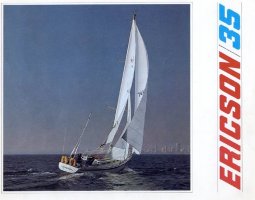Session 2
Picking up where I left off.
1) On the face of it, there are lots of similarities between the E25, E25+, E26, and E27. How does a designer find ways of adding differentiatable functions/features when working in one foot increments?
You have to remember that the different Ericson models were designed
over many years. Whenever the management felt there was a "hole"
in the line, they would fill that void either by commisioning a new
design, or modifying an existing mold to create a new boat. It's not
surprising that there are similarities.
In his opinion, did Ericson's Mexican production boats have any substantial quality differences from the California boats?
No.
Was the Ericson 30-1 first laid up in two separate sections, or was it laid up in one piece?
The 30-1 was done in a 2 part mold.
Second question, and this is definitely design, can he comment on the evolution of the keel and rudder designs?
The early boats like the 41 have that CCA shape to the keel. This was
in vogue at the time. The 70's boats were IOR influenced and we see
the appearance of the bustle at aft end. Tank testing did much to help
see what was really going on below the waterline. The 80's boats had
the delta keel. Options like shoal and deep draft were offered as they
had switched to external bolt on keels by this time.
Principal Partner
I think it would be nice to know which ericson models were original designs and which were expanded or shrunken versions of another design. I have heard that Ericson did this.
Sorry, but I cannot comment on this except to say that he wasn't
happy when this occured.
What was the best idea the designer had that never made it into production?
I don't know about the best idea. Some of the boats were expensive to
build and we see that bit by bit, the factory" value engineering" the products.
An example of this is the disappearance of an inward turning hull flange and
through bolted toerail replaced with an outward turning flange covered with a
plastic rubrail.
Was there competition with the other designers for working with companies, or a gentleman's agreement that designs would not 'butt' in?
I don't think there was any gentlemans agreement. It was a free
market and you lived or died by your work. If your designs sold well,
then you lived to draw another day.
Did Mr. King get together with his peer and exchange ideas?
Never. R&D was jealously guarded, and competition from other
manufacturers was fierce.
If a high school student wanted to follow in his steps, what would he suggest, schools, apprenticeships, .....?
When asked this, he laughed and said they should pick another career.
He is first to admit that he was extremely fortunate to be in the right
place at the right time. I will add he also was extremely talented.
Basically I would like to know what makes his design of an interior so much better than other designers, which I will allow to be nameless. Can he put into words what goes on in his head?
Well that's flattering but in small boats, there is only so much you can
do with the interior. Basically the Ericson's have standard layouts with
a couple of options. I think they did very nice interiors for a production
boat.
Performance-wise, then, I would like to know if Mr. King agrees with me that the fore & aft weight distribution is one of the primary "cons" of the hull design and if he can answer why the engineering team would put the forward water tank in that position knowing its potential effect on sailing performance.
On a small boat, you don't have many options for water tank locations.
Usually, they are under the berths.
That's it for this session.
 , a couple things I've seen...my shear at the bow seems higher, my stern seems more vertical and narrower, the steering quadrants are totally different. (And I won't mention the obviuos interior layout design changes.) First, am I correct, and what other design changes were made to the 38 series?
, a couple things I've seen...my shear at the bow seems higher, my stern seems more vertical and narrower, the steering quadrants are totally different. (And I won't mention the obviuos interior layout design changes.) First, am I correct, and what other design changes were made to the 38 series?


